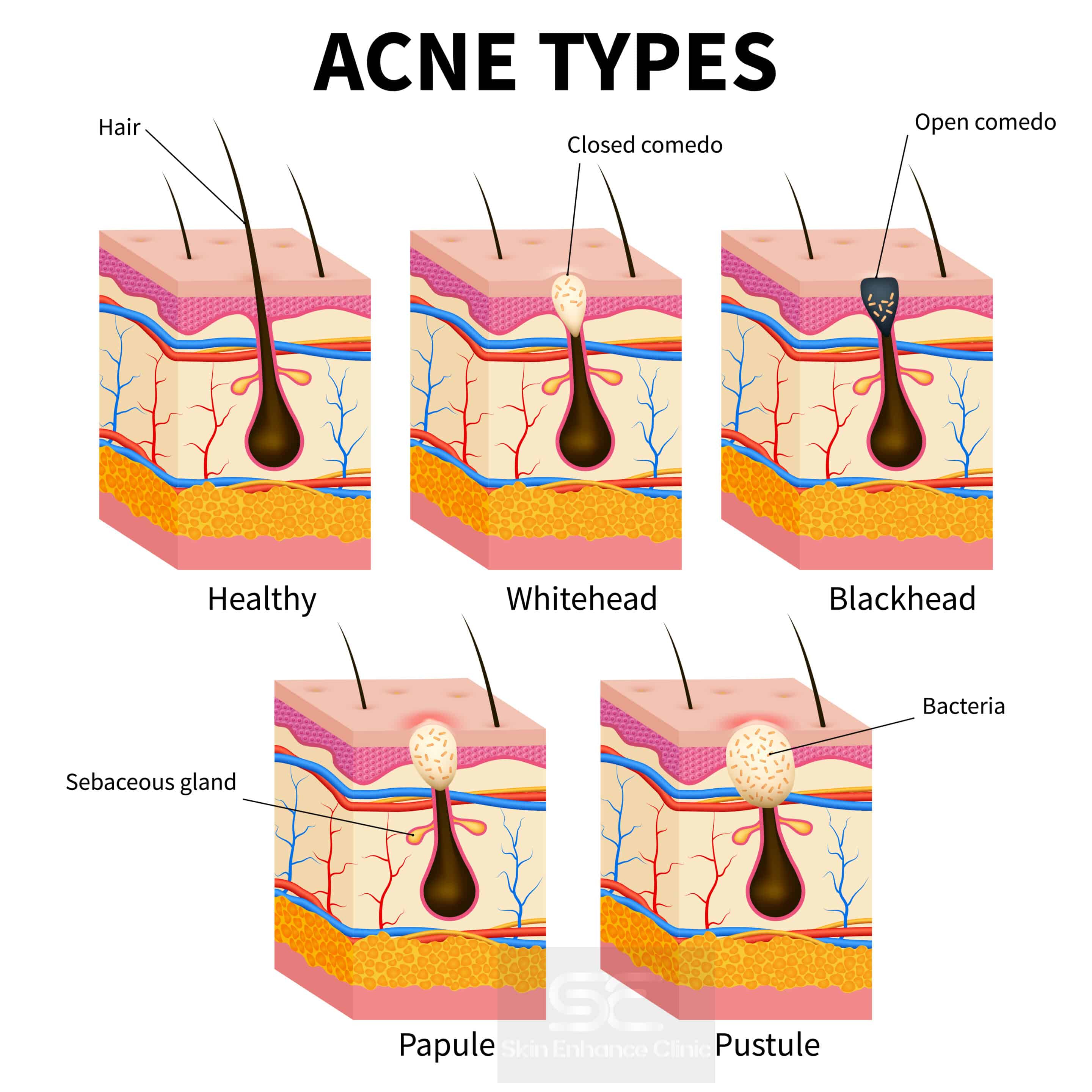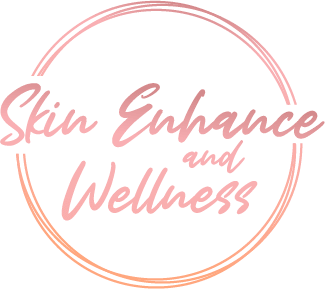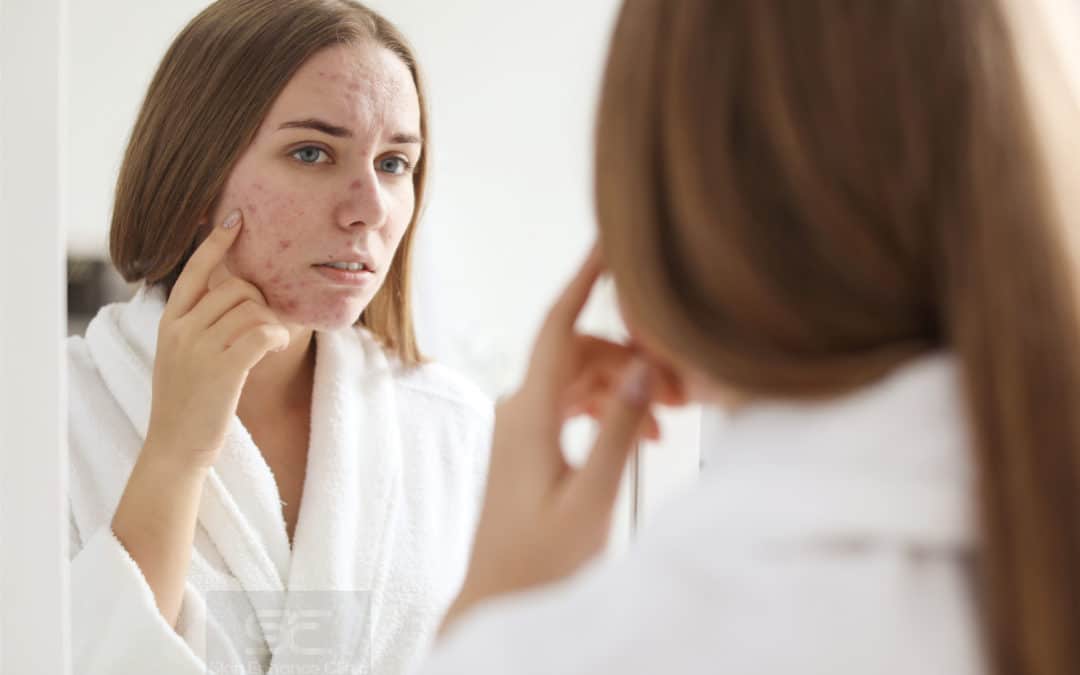Acne is a common condition we associate with adolescence, but did you know that it can develop in adults in their 30s to 50s?
Why do you get it?
Acne arises from a combination of 3 different processes:
- Abnormal barrier function
- Excess sebum production
- Overgrowth of bacteria
The skin is your barrier from the environment. It prevents water loss from the surface. In normal skin, there is a fine balance between all its components, namely water, lipids, and proteins. Disrupted skin will stop maintaining a good barrier function. When your skin loses water, it is called Trans Epidermal Water Loss. If there is TEWL, the skin produces more keratin in an attempt to slow down the water loss. This makes skin cells thicker and more ‘hornier’ than normal. This is called ‘keratinisation’.
Each hair follicle in the skin is attached to a sebaceous gland producing sebum (oil). If there is excess water loss from the surface, the skin compensates by producing excess oil. The glands are under the control of hormones.
The skin normally contains a harmless bacteria, Propionibacterium acnes (P.acne). If the pores are clogged, the bacteria can get inside. The environment within the pore is perfect for it to multiply quickly and flourish. The proliferation of these bacteria triggers an immune reaction in the skin.
In summary, there is increased ‘keratinisation’, overactivity of the sebaceous gland, and bacterial overgrowth.
What does acne look like?

Acne begins with a blocked pore. Normally dead skin rises to the surface of the pore and is shed by the skin. When there is excess sebum, the dead cells stick together within the pores. Instead of rising to the surface, they get trapped inside forming a comedone. Whiteheads are simply clogged pores or closed comedones.
Blackheads are open comedones. When the sebum within a pore is exposed to air and oxidizes, it changes colour. Some people only get white or blackheads neither of which are painful.
Occasionally these progress to painful lesions. This is because sebum is powerful at triggering inflammation. The body mounts an immune reaction to the blocked pore. This results in blemishes and papules. They appear as raised red bumps that are tender to touch but hey do not contain pus.
You may notice pustules forming. Pustules appear as yellow pus-filled bumps on the skin which are tender.
In more severe forms, cysts or nodules may develop. These are larger, harder tender bumps. They may either burst or heal without bursting. Cysts may or may not contain pus and may remain for weeks or months. Scarring is extremely likely following cyst or nodule formation. Scars are permanent and are subject to pigmentary changes.
The commonest sites of acne correspond to the highest density of sebaceous glands. Common sites include the face, back, and chest. Uncommon, but possible sites for acne include shoulders, upper arms, and buttocks.
Is acne different in adults?
In adolescence, boys are more often affected than girls. In contrast, adult acne is more common in women. As adult skin differs from teenage skin, so is its management. Adult Acne
What triggers it?
Hormones
The sebaceous glands are sensitive to hormones, especially to androgens like testosterone. Testosterone stimulates sebum production. During the menstrual cycle, fluctuation in hormone levels triggers breakouts. Similarly, at menopause, the declining female hormone oestrogen creates a relatively stronger testosterone presence. Some hormonal contraception methods, as well as conditions that cause hormonal abnormality like polycystic ovarian syndrome, affect acne. In conclusion, hormonal imbalances trigger acne.
Family History
Some people are genetically more susceptible than others, so it may run in families.
Stress
When we are stressed, we produce more cortisol. Higher cortisol levels subsequently increase androgen levels which in turn stimulate sebum production.
Skin and hair care products
Any of these can affect the normal functioning of the skin, weaken it or cause clogging of the pores and predispose to acne.
Diet
Food that has a high glycaemic index causes spikes in sugar levels and this is thought to increase sebum production.
How can I manage it?
Despite many claims, acne cannot be treated overnight. It is a chronic condition and needs commitment.
Treatment aims to:
- Repair skin barrier to optimise healthy skin function
- Dampen down sebaceous gland activity and sebum production
- Minimise bacteria level
- Reduce inflammation
- Improve exfoliation to reduce blockage of pores
- Refine skin texture
- Treat pigmentation
- Maintain results and prevent relapse
It can often take 6-8 weeks for the improvement of acne to be seen.
Skincare options
Here are some key ingredients used in medical skincare:
Salicylic acid
Salicylic acid is a multifunctional ingredient. As a beta-hydroxy acid, it promotes cell turnover and gets rid of dead cells. As an oil-loving ingredient, it reaches into the pores and breaks down the sebum. Additionally, it has anti-inflammatory properties. Salicylic acid is available as a cleanser or a serum.
Vitamin A (Retinoids)
Retinoids are super serums with multiple benefits. Firstly they reduce comedones formation by preventing dead cells from clogging your pores. Secondly, they improve skin hydration. Thirdly they shrink pores and lighten pigmentation. Fourthly they reduce sebum production. Most importantly, they block inflammatory pathways that would normally lead to papules or even cysts. Above all, retinoids normalise your skin.
The higher the dose the better but expect to get temporary side effects. These include redness, peeling, skin irritation, and dryness. Nonetheless, the side effects subside with continued use as your skin adjusts.
It can take 12 weeks for retinoid serums to show optimal results.
In the long term, retinoids have collagen remodeling properties that help with scarring.
What are the benefits of Vitamin A derivatives?
Benzoyl peroxide
This has 2 actions in acne management. Firstly, it reduces the bacteria P.acnes. It releases oxygen into the follicles and oxygen is toxic to the bacteria. Secondly, it breaks down comedones. Although it can work very fast at improving acne, staining is a problem as it can bleach bedding, towels, and clothes.
Antibiotic containing serums
Topical antibiotics are used for their anti-inflammatory properties. Antibiotic-resistance is high risk so they are usually combined with other agents.
Oral medication
The following medications are available on the NHS.
Oral Antibiotics
Antibiotics are used for their antibacterial and anti-inflammatory properties, but again resistance is likely, and results can take up to 6-12 weeks.
Hormonal treatment
Oestrogen-containing contraceptive pills can be used to decrease the level of free androgens. This can take 3-6 months to work and acne may return on discontinuation.
Isotretinoin
This is a dermatologist-prescribed medication containing the oral form of vitamin A. Although very effective, it has serious side effects and requires close monitoring with blood tests. It is normally reserved for more severe types of acne.
Other treatments
In-clinic treatments with energy-based devices such as light therapy, laser can help acne. These treatments reduce the pores and or reduce inflammation. Alternatively, chemical peels exfoliate the skin allowing active products to penetrate while increasing cellular turnover. This is a very effective treatment to achieve progressive results. In other words, combining clinic treatments with the right home care gets the best results.
When do you need to seek help for acne?
As soon as possible!
Tips to reduce acne
- Don’t wash your skin too often. Striping the skin of oil stimulates more sebum production.
- Avoid harsh agents. Skin irritation promotes sebum production.
- Use an appropriate cleanser twice daily.
- Avoid picking or squeezing the spots as trauma causes more inflammation and can lead to permanent scarring.
- Avoid pore-blocking skincare, haircare or make-up.
- Wear sun protection.
For a bespoke treatment plan to manage your acne, book an appointment with me via email drtash@skinenhanceclinic.com or contact me via the website https://skinenhance.co.uk/


Recent Comments